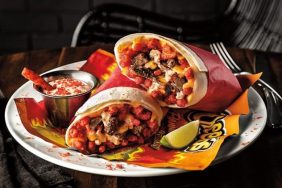Fans of The Iron Chef will remember Masaharu Morimoto from both the American and Japanese versions of the show. Since his time on TV, Chef Morimoto has expanded his already ubiquitous presence as an international restaurateur by opening sushi and fusion restaurants in Tokyo, Mumbai, and Mexico City in addition to a multitude of stateside ventures.
With meticulous attention to detail and a visual “wow” factor in both the presentation of his cuisine and the design of his restaurants, Chef Morimoto has set the culinary bar impressively high. Amusing, then, that he never meant to be a chef: as a young man, he was drafted to be a major league baseball catcher in his native Japan. After a shoulder injury sidelined that dream, he studied sushi and kaiseki (the traditional Japanese multi-course meal). Clearly, the backup plan panned out.
We asked this celebrated chef about the new Morimoto restaurant in the MGM Grand Las Vegas, how to make ordering sushi less intimidating, and the importance of plating.
Crave: How does culinary training differ in Japan from the U.S?
Chef Masaharu Moriomoto: Basically, they don’t differ much. The apprenticeship system in the Japanese culinary scene is fading, but a chef is still considered as a specialist or craftsperson. The rest of the difference comes from characteristics and the cultural aspect of the nation.
How do you define “fusion” food? Do you think it’s gaining in popularity in the United States?
Just like many other cultural elements, food travels from its birthplace to another part of the world. Then it evolves and intermixes with those other foods that have also traveled from somewhere else. There are elements that each culture’s food can learn from another’s. Once tastes, traditions, and ingredients are understood, that is what gives us the ability to put two different flavor profiles together and create enjoyable fusion. Yes, fusion is becoming more popular in the United States.

Sushi Box
Some people seem hesitant to eat, or are intimidated by, sushi. What would you say to an un-adventurous eater to encourage him to try it?
Don’t be afraid of sushi–it’s one of the most exquisite but accessible kinds of food. Sit at the sushi bar and order omakase (the chef’s choice menu). Don’t be afraid to ask questions, let them know it’s your first visit to a sushi restaurant. Try the sushi as the chefs have intended–please do not drown it in soy sauce!
Also: Interview | Chef Tom Douglas On Seattle’s Restaurant Scene
You have restaurants worldwide. Do you have to alter your concepts, recipes, or menus to accommodate different cultural preferences or dietary restrictions based on the country the restaurant is in? Or do you expect diners to step outside their comfort zones?
Each of my restaurants is unique in its own way based on the local background: culture, customs, economics, history. To me, it’s important to satisfy local palates. It’s important to sense and grasp what guests are looking for, so I take my local chefs’ and managers’ opinions very seriously in order to give each different location what it wants.

Oyster Foie Gras
If you had to choose between unattractive food that tasted amazing or prettily-plated food that tasted mediocre, which would you choose and why?
If I must choose, I would go for unattractive food that tastes amazing. The taste comes first. It goes without saying that beautifully plated food that tastes amazing is the best.
Is innovative design just as important as the items on the menu when opening a restaurant? Why or why not?
Innovative design tops off the guests’ experience, but there is nothing as important as the items on the menu. If the food on the menu is not well-executed or made with sub-par ingredients, it does not matter how beautiful the design is. Nothing can save mediocre food!

Morimoto Sushi Bar
What can diners expect at your new restaurant at the MGM Grand in Las Vegas?
I want to offer world cuisine, just as I do at my other locations. People visit Las Vegas from all over the world. They know good food. The experience in Las Vegas is going to be reflective of my other restaurants across the world but will have the additions of my first Teppan [a style of cooking on an iron grill] section. I want to offer a fun and entertaining experience to my guests.
What is your favorite thing to eat or drink after a long night of cooking for others?
Anything my wife prepares for me. I don’t cook at home at all. Her menu has become more and more vegetarian so I do miss meaty foods after a long night of cooking sometimes. But I basically eat anything.






